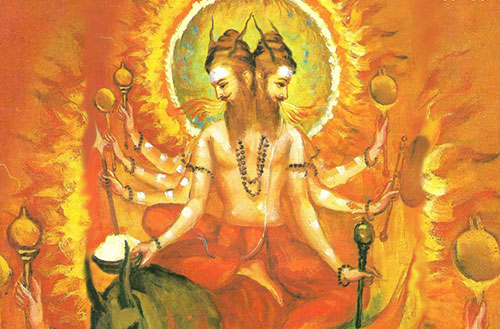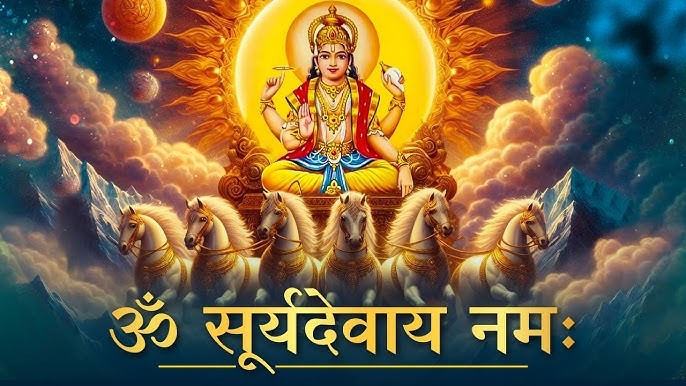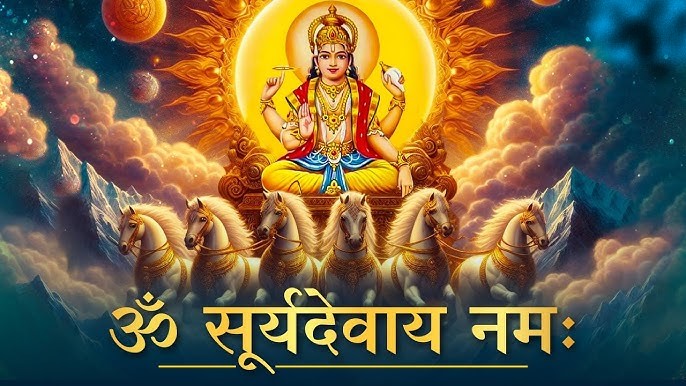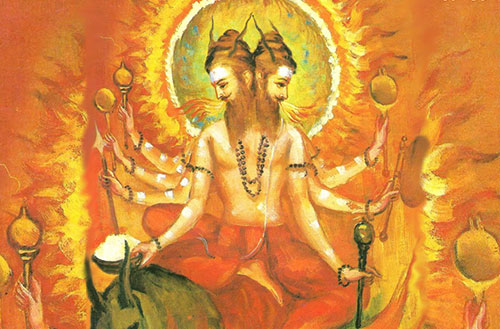
October 05, 2025
Dieties/devta gan
3 min read
Agni
Agni, the God of Fire, holds a special place in Hinduism. From ancient times, fire has been seen as a bridge between humans and the divine. In Vedic rituals, Agni carries our prayers and offerings to the gods. Whether it’s a havan, yagna, or a simple diya lit at home, fire is a symbol of purity, transformation, and devotion.
Agni is not just an element — it represents life, energy, and spiritual awakening. The flame reminds us that true light comes from within, and when we live with truth and sincerity, we become one with the divine.
Agni — The Sacred Fire in Hinduism and Its Spiritual Science
Introduction
Fire, or Agni, holds a central place in Hinduism. It is more than a physical flame — it is a living
deity, a purifier, and a cosmic force.
From Vedic rituals to daily offerings, fire represents energy, transformation, and the bridge
between the earthly and the divine.
---
1. Agni as a Deity
Agni is one of the primary Vedic gods, known as the messenger between humans and gods.
He carries offerings to the deities during a Havan or Yajna.
Symbolically, Agni represents inner wisdom, purity, and the transformative power of
consciousness.
Mysterious fact: Agni is considered both visible and invisible — the visible flame and the subtle
energy within all beings.
---
2. Fire as Transformation
Fire consumes, purifies, and transforms matter.
Spiritually, it represents burning away ignorance, ego, and negativity.
Rituals involving fire symbolize letting go of attachments and inviting divine energy.
Hidden insight: Just as fire converts fuel into energy, spiritual practices convert thought and
action into inner power and wisdom.
---
3. Agni in Vedic Rituals
Havan/Yajna: Offerings of ghee, herbs, and grains are made into the sacred fire while chanting
mantras.
The fire radiates energy, purifies the surroundings, and creates a resonant spiritual field.
Different mantras are used to activate various cosmic energies during the ritual.
Mysterious fact: Studies show that rituals with fire ionize the air and increase positive energy in
the environment — a subtle science ancient sages understood intuitively.
---
4. Fire as Inner Energy
Agni also represents digestive fire (Jatharagni) in Ayurveda, which governs metabolism, energy,
and vitality.
Meditating on Agni or practicing Agni meditation strengthens inner energy, removes mental
toxins, and ignites spiritual awareness.
Kundalini energy is often compared to an inner flame rising through the chakras.
---
5. Fire in Festivals
Festivals like Diwali (lights) and Makar Sankranti (sun fire) celebrate Agni.
Lighting lamps symbolizes awakening consciousness, dispelling darkness, and maintaining
harmony with cosmic cycles.
Fire is a medium to connect humans to solar and cosmic energies.
---
6. The Symbolism of Flames
Three flames often represent the three Vedas or the three Gunas (Sattva, Rajas, Tamas).
Fire’s upward movement symbolizes aspiration toward higher consciousness.
The color of the flame, its movement, and intensity are considered mirrors of spiritual energy
and environmental harmony.
---
7. Hidden Science
Fire generates light, heat, and ions — purifying the air and energizing the surroundings.
Chanting mantras while performing Havan produces resonance in air molecules, enhancing
concentration and emotional stability.
Ancient sages knew fire creates a microcosmic energetic field, aligning humans with cosmic
rhythms.
---
Conclusion
Agni is a bridge between the physical and the spiritual, the seen and unseen, the human and
the divine.
Every ritual, every flame, and every offering is an invitation to awaken consciousness and
harmonize with universal energy.
Hidden Thought:
When you light a lamp or gaze into a sacred fire, remember — you are witnessing the eternal
flame of consciousness within yourself, burning away illusion and awakening wisdom.
Introduction
Fire, or Agni, holds a central place in Hinduism. It is more than a physical flame — it is a living
deity, a purifier, and a cosmic force.
From Vedic rituals to daily offerings, fire represents energy, transformation, and the bridge
between the earthly and the divine.
---
1. Agni as a Deity
Agni is one of the primary Vedic gods, known as the messenger between humans and gods.
He carries offerings to the deities during a Havan or Yajna.
Symbolically, Agni represents inner wisdom, purity, and the transformative power of
consciousness.
Mysterious fact: Agni is considered both visible and invisible — the visible flame and the subtle
energy within all beings.
---
2. Fire as Transformation
Fire consumes, purifies, and transforms matter.
Spiritually, it represents burning away ignorance, ego, and negativity.
Rituals involving fire symbolize letting go of attachments and inviting divine energy.
Hidden insight: Just as fire converts fuel into energy, spiritual practices convert thought and
action into inner power and wisdom.
---
3. Agni in Vedic Rituals
Havan/Yajna: Offerings of ghee, herbs, and grains are made into the sacred fire while chanting
mantras.
The fire radiates energy, purifies the surroundings, and creates a resonant spiritual field.
Different mantras are used to activate various cosmic energies during the ritual.
Mysterious fact: Studies show that rituals with fire ionize the air and increase positive energy in
the environment — a subtle science ancient sages understood intuitively.
---
4. Fire as Inner Energy
Agni also represents digestive fire (Jatharagni) in Ayurveda, which governs metabolism, energy,
and vitality.
Meditating on Agni or practicing Agni meditation strengthens inner energy, removes mental
toxins, and ignites spiritual awareness.
Kundalini energy is often compared to an inner flame rising through the chakras.
---
5. Fire in Festivals
Festivals like Diwali (lights) and Makar Sankranti (sun fire) celebrate Agni.
Lighting lamps symbolizes awakening consciousness, dispelling darkness, and maintaining
harmony with cosmic cycles.
Fire is a medium to connect humans to solar and cosmic energies.
---
6. The Symbolism of Flames
Three flames often represent the three Vedas or the three Gunas (Sattva, Rajas, Tamas).
Fire’s upward movement symbolizes aspiration toward higher consciousness.
The color of the flame, its movement, and intensity are considered mirrors of spiritual energy
and environmental harmony.
---
7. Hidden Science
Fire generates light, heat, and ions — purifying the air and energizing the surroundings.
Chanting mantras while performing Havan produces resonance in air molecules, enhancing
concentration and emotional stability.
Ancient sages knew fire creates a microcosmic energetic field, aligning humans with cosmic
rhythms.
---
Conclusion
Agni is a bridge between the physical and the spiritual, the seen and unseen, the human and
the divine.
Every ritual, every flame, and every offering is an invitation to awaken consciousness and
harmonize with universal energy.
Hidden Thought:
When you light a lamp or gaze into a sacred fire, remember — you are witnessing the eternal
flame of consciousness within yourself, burning away illusion and awakening wisdom.


